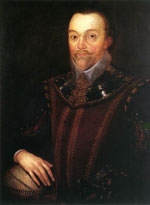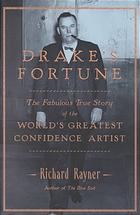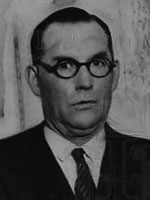The Francis Dake Association Hoax
"Elizabeth Drake (first and only married child of John Drake and wife) was born March 5, 1724. She married first William Corey (son of John Corey of North Kingston, R. I.) April 5, 1742. They had 2 sons. William Corey, her husband, died in 1746 or 7. She then married Thomas Corey (brother of her first husband) Feb. 15, 1748, and to them were born 4 children."
This bit of information, no matter what Cory line you were a member of, persuaded many Corys in the early 20th Century to think that they were related to Sir Frances Drake and thereby become the victims of The Drake Association Hoax. To further complicate things, a fake genealogy crept into many records. For example, see Direct Lineage of Joseph Skinner Corey Traced Back to Thomas Drake Youngest Brother of Sir Francis Drake and Forward Through a Line of Descendent to 1963. This shows that this hoax was still believed as late as 1963.
 The Drake Fraud was based on real-life Sir Francis Drake, Vice Admiral in Queen Elizabeth's
Royal Navy, and adventurer. Drake was knighted by the Queen in 1581. He was second-in-command of the English fleet against
the Spanish Armada in 1588. He became insanely rich after helping England defeat the Spanish Armada in 1588 and collecting
his share of the Spanish treasure. While tales of Drake's high seas adventures were applauded through out England
and made him a hero to the Spanish he was a pirate. He died of dysentery after unsuccessfully attacking San Juan, Puerto
Rico in 1596. He died without heirs and at some point, that inspired the notion that there were millions and millions
of dollars waiting to be collected by some heir, somewhere.
The Drake Fraud was based on real-life Sir Francis Drake, Vice Admiral in Queen Elizabeth's
Royal Navy, and adventurer. Drake was knighted by the Queen in 1581. He was second-in-command of the English fleet against
the Spanish Armada in 1588. He became insanely rich after helping England defeat the Spanish Armada in 1588 and collecting
his share of the Spanish treasure. While tales of Drake's high seas adventures were applauded through out England
and made him a hero to the Spanish he was a pirate. He died of dysentery after unsuccessfully attacking San Juan, Puerto
Rico in 1596. He died without heirs and at some point, that inspired the notion that there were millions and millions
of dollars waiting to be collected by some heir, somewhere.
Since his death, there has been much debate over his lineage. Sir Francis Drake knew very little about his ancestry and because of his wealth and fortune, many have claimed to be a descendent and heir to him. In 1870, the first Sir Francis Drake Association was formed to once and for all settle the estate of Sir Francis Drake. Oddly, the two most active members of the Association were later found not to be direct descendants of Drake.
In 1913 thousands of people with the last name Drake received a letter from the "Sir Francis Drake Association," an organization founded for the purpose of settling the estate of the legendary British buccaneer who had died 300 years earlier. The letter claimed that the estate was still tied up in probate court, and that since Drake's death in 1596 the value had grown to an estimated $22 billion. Any Drake descendant who wanted a share of the estate was 'Welcome-all they had to do was contribute toward the $2,500-a-week "legal expenses" needed to pursue the case. When the estate was settled, each contributor would be entitled to a proportional share. There was no time to waste-the fight was underway and any Drake descendant who hesitated risked being cut out entirely. To claim a part of the estate, the “descendants” would have to pay for legal expenses to trace their lineage to Sir Francis Drake and move the claim through the legal system. In all, approximately 2 million dollars was collected.
However, the letter and the organization, the Sir Francis Drake Association, was a hoax. The Sir Francis Drake Association was the work of Iowa farmer-turned-conman Oscar Merrill Hartzell. But he didn't invent the hoax (the first of hundreds of similar swindles took place within months of Drake's death in 1596.) It swindled thousands of people in the American Midwest, all of whom purchased "shares" to help defray the legal expenses in the fight to free up the Drake fortune. The "shares" promised to pay out as much as a thousand to one. People were happy to fork over cash by the bushel basket, all in hopes of being amply rewarded when the legal battle was finally won.
 Hartzell
was a farmer's son from Madison County, Iowa who worked as a farmer and a deputy sheriff. According to Hartzell,
in 1915 he met a couple of con artists who promised to turn his mother's $6000 into $6 million by giving him a share
of the held fortune of Sir Francis Drake. When he tracked down the crooks that had swindled her and realized how
much money they were making, Hartzell decided that rather than call the police, he would keep quiet ... and launch his
own scam.
Hartzell
was a farmer's son from Madison County, Iowa who worked as a farmer and a deputy sheriff. According to Hartzell,
in 1915 he met a couple of con artists who promised to turn his mother's $6000 into $6 million by giving him a share
of the held fortune of Sir Francis Drake. When he tracked down the crooks that had swindled her and realized how
much money they were making, Hartzell decided that rather than call the police, he would keep quiet ... and launch his
own scam.
For some reason - no one will probably ever know why - the con artist running The Drake, Sudie Whiteaker, took Hartzell under her wing and employed him to run errands. Eventually, after the con artist, her lawyer, Milo Lewis, and Hartzell proceeded to move to London to live in an opulent lifestyle and to run the scam from afar. By 1922, he had succeeded in cutting out his former employers and writing letters to their "shareholders" stating that he had taken over the legal battle for the Drake fortune. He told the families who had invested in the "campaign" that he was negotiating with the British government and needed even more money for expenses. His agents in the Midwest—some of which believed in the scheme themselves - collected the money.
Hartzell greatly improved on what was already a successful scam, introducing drama to his letters and accusing his former employers of all kinds of evil doings. On August 9, 1922, the British Home Office informed the American embassy that there was no unclaimed Sir Francis Drake estate. Hartzell explained that the estate was not unclaimed because it belonged to Drexel Drake (a nonexistent colonel) and had assigned the rights to him. Despite continual promises that the legal battle would soon be over and the billions would start flowing, Hartzell kept stalling, as the best con men do.
Unfortunately, Hartzell had not broken any British law, so British police could not arrest him. The FBI investigated and announced that Drake's wife had duly inherited his estate in 1597. That information did not stop the donations. When Ed Smith, Iowa Secretary of State, tried to convince the state legislature to act, the public and Hartzell's supporters protested, saying that they could donate to whomever they wanted; the legislature did nothing.
After the Wall Street Crash of 1929 and during the Great Depression, Hartzell's followers seemed to become even more desperate and sent him even more money. The desperation only fueled speculation. He even claimed that the impending release of the Drake fortune had CAUSED the Depression! Hartzell eventually expanded the scam to target people who weren't even named Drake.
On October 11, 1930, John Maynard Keynes was arguing in an article for deficit spending to alleviate the Depression and mentioned that Queen Elizabeth had invested Drake's loot—which Drake had given to the crown—for the benefit of the country. Hartzell seized this as a proof of his claims and his agents in the USA spread copies of the article to his followers.
Eventually United States Postal Service inspector John Sparks, with help from the British police, seized some of the Hartzell's agents and forced them to reveal the scam. At the same time, Scotland Yard arrested some of Hartzell's British associates. Britain deported Hartzell to USA and he was sent to Iowa for trial in 1933.By the time Hartzell was caught, he had conned approximately 70,000 out of approximately $2 million. The New York Times reported on February 17, 1933:
DRAKE 'HEIR' IS HELD UNDER $10,000 BOND
Hartzell, Seized on Arrival From England, Denies Mail Fraud Charge.
Oscar Merrill Hartzell, who was recently deported from England as an undesirable alien, because of his activities in drawing money by mail from his countrymen in Iowa, on the representation that he held an assigned claim on the mythical estate of Sir Francis Drake, was arrested yesterday when he arrived here on the French liner Champlain.
A mild-mannered little man with ruddy cheeks, which owed their color, Federal authorities said, to high living in London cafés on the $800,000 he collected from victims in America, the prisoner told Alvin MeK. Sylvester, Assistant United States Attorney, that everything "is above board, and I can prove it."
Mr. Sylvester, accompanied by George Z. Oetzel, Deputy United States Marshal, took Hartzell from the ship to the court of United States Commissioner O'Neill, before whom he waived examination, consenting to return today to Des Moines, Iowa, where he once was a candidate for Sheriff, to answer charges of mail fraud.
Commissioner O'Neill held Hartzell in bail of $10,000 on the complaint of John Sparks, postoffice inspector of Sioux City. G. W. Ray, American Vice Consul, who investigated the Hartzell case in London, also returned on the Champlain. He said he had been ordered home, but saw no connection with the fact that Hartzell was on the same vessel.
 Hartzell was tried in Sioux City, Iowa in 1933. His trial turned into something of a
comedy, with many of Hartzell's victims stalwartly defending him against charges. Many of the people who had been
along with him for so many years simply could not believe the scheme wasn't real. Many of those who had donated,
however, refused to believe they had been conned and donated nearly $350,000 towards Hartzell’s legal fund. Despite
being able to afford a good legal defense, Hartzell was convicted of mail fraud and was sentenced to 10 years in prison
and sent to Leavenworth Penitentiary. By that time, he had run his scam for over 15 years. Even after his sentence,
some of his agents collected more donations—$500,000 for the next year.
Hartzell was tried in Sioux City, Iowa in 1933. His trial turned into something of a
comedy, with many of Hartzell's victims stalwartly defending him against charges. Many of the people who had been
along with him for so many years simply could not believe the scheme wasn't real. Many of those who had donated,
however, refused to believe they had been conned and donated nearly $350,000 towards Hartzell’s legal fund. Despite
being able to afford a good legal defense, Hartzell was convicted of mail fraud and was sentenced to 10 years in prison
and sent to Leavenworth Penitentiary. By that time, he had run his scam for over 15 years. Even after his sentence,
some of his agents collected more donations—$500,000 for the next year.
Amazingly, Hartzell struggled to keep the scam going, even from his prison cell. Eventually he went mad. He was later transferred to a mental institution and died in 1943 believing that he was Sir Francis Drake himself.
For a more detailed account of the Drake Hoax, see Handbook of Frauds, Scams, and Swindles: Failures of Ethics in Leadership By Serge Matulich, David M. Currie, Chapter 5.

